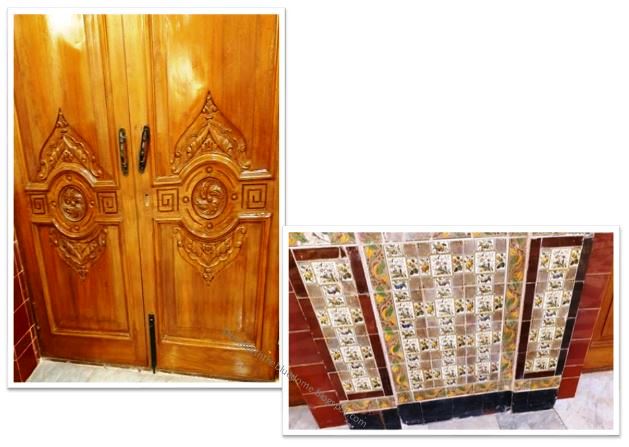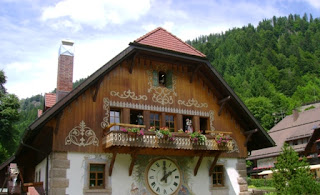Visiting National Museum of Indian Cinema Mumbai - 1: The Gulshan Mahal Galleries
Gulshan Mahal is a 19th-century bungalow that houses the first section of the NMIC Museum, Mumbai. The second is the Modern Glass Galleries in its own independent building, just adjacent to the bungalow. Architecturally Gulshan Mahal is a magnificent heritage structure and you can capture some superb images from various angles. Visitors can check out the interesting history of this bungalow at the entrance to it, on the display board on the right-hand wall.
There are 9 galleries here. I turned right from the main hall so as per my walkabout tour, I am mentioning the gallery numbers.
On the ground floor is-
Gallery 1 and Gallery 2: Origin of Cinema and the Entry
of Cinema in India
 |
| Cinematograph |
The gallery also has an explanation of the early Indian
traditions of visual storytelling, how cinema developed with the Lumiere
Brothers, and the cameras they used, such as the hand-cranked camera and the
Cinematograph (a 3-in-2 equipment with camera, processor and projector). Learn about
the first reels at Watson's Hotel in Mumbai, and later at the Novelty theatre.
From there I turned right to enter the next two galleries.
Gallery 3 and Gallery 4: The Silent Era of Indian Cinema,
and the Advent of Sound
As the segment's titles indicate, here you see the transition from the times when movies had no sound to those which did. On display, there is an actual 35mm RCA Optical Recorder which was used for recording final optical soundtracks for printing purposes. The display panels on the walls showcase the stars of the soundless films who commanded a fan following with their emotive expressions alone and continued to do so into the talking era. These include Sulochana (Ruby Myers), Gohar Mamajiwala, Kamlabai Gokhale who starred in Dadasaheb Phalke’s Mohini Bhasmasur along with her mother Durgabai Kamat (they were the first ladies in Indian cinema), Dinshaw Billimoria, Master Vithal, Prithviraj Kapoor, etc.
Then go up the lovely staircase with posters lining the walls to the first floor.
 |
| Staircase leading to upper galleries |
Gallery 5: Regional Cinema
 |
| Regional Cinema Gallery |
In this gallery are display boards dedicated to regional cinema niches, including Marathi, Kannada, Malayalam Telegu, Tamil, Assamese, Manipur, Odia, Bengali, etc. In addition to the names of the stars, there are a lot of informative snippets on each. A few examples- Prabhat Film Company’s Sant Tukaram was the first Indian film to win the best film award at the 1937 Venice Film Festival; Vellinakshatram (1949) was the first movie to be made in Kerala; Joymoti by Jyotiprasad Agarwala was the first Assamese film; Sita-bibaha, directed by Mohan Sundar Deb Goswami, was the first Odia talkie.
Gallery 6: New Wave and Parallel Cinema
This section gives a brief overview on the display boards in the
passage outside gallery 5, mentioning the advent of Eastman colour photography
in Hindi cinema and the impact of digital technology on the distribution,
exhibition, and projection of films.
The most fascinating feature to see here is the tiny
screens in which you can watch movies of the past. I was taken down nostalgia lane on the screen showing Ashok Kumar’s famous Rail Gaadi song (train song) in
Hrishikesh Mukherjee's movie 'Aashirwad' (this particular screen was in the
passage). Recalling this song instantly brought a smile to my face.
 |
| Tiny film screen |
Then come down back to the ground floor, go across the main hall where you first started and you will enter the galleries of-
Gallery 7: Creative Resonance
 |
| Commemorative stamps |
You will get a glimpse of Indian cinema’s creative stalwarts of the post-independence era, such as V. Shantaram, Mehboob Khan, Guru Dutt, Ritwik Ghatak, etc. Don’t miss the superb set of commemorative stamps on directors and stars of Indian Cinema.
Gallery 8: Studio Era
Learn about the major studios which shaped the various
film industries across India. Check out the film magazine snippets, posters and
publicity material of earlier eras.
 |
| Various Equipment |
The central exhibit has a host of cameras, sound and light equipment. What caught my eye were the "shadow" images on the wall behind. Brilliant creativity!
 |
| Brilliant wall imagery |
 |
| Old Film Posters |
Here's a hilarious critical analysis of songs in an old film magazine-
 |
| Film magazine snippet |
Gallery 9: Impact of World War II
This section showcases the movies from the 1930s to the 1940s, when the freedom movement in India, the Second World War and other socio-political events took place.
Back in the main hall, in case you missed checking out the ceiling displays-
 |
| Main Hall |
And don't miss out on the beautiful tiles and door designs-
I mentioned the stunning architectural features of the Gulshan Mahal. Here's one that I took, lucky to get a shot with a bird in the frame (is that a hawk?)
 |
| Gulshan Mahal roof |
There are elephant head sculptures at the corners, and this particular one had a tiny plant above it, so it looks as though the elephant is reaching up with its trunk for it-
 |
| Elephant Head Sculpture |
You thus have much to enjoy - learn about Indian Cinema's rich history, take a breather in the crisp, clear air in the outdoor greenery, and capture stunning photographs in and around the Gulshan Mahal bungalow which is part of the National Museum of Indian Cinema, Mumbai.
NMIC Mumbai Museum Contact Information
Address: 24, Dr. G. Deshmukh Marg (Pedder Road), Cumballa Hill, Mumbai- 400026.
Ph: +91-022-23551377
Email: nmic@filmsdivision.org / nmicmumbai@nfdcindia.com
Website: https://nmicindia.com/
Additional Details: Timings, Entry Fee, and More






Comments
Post a Comment